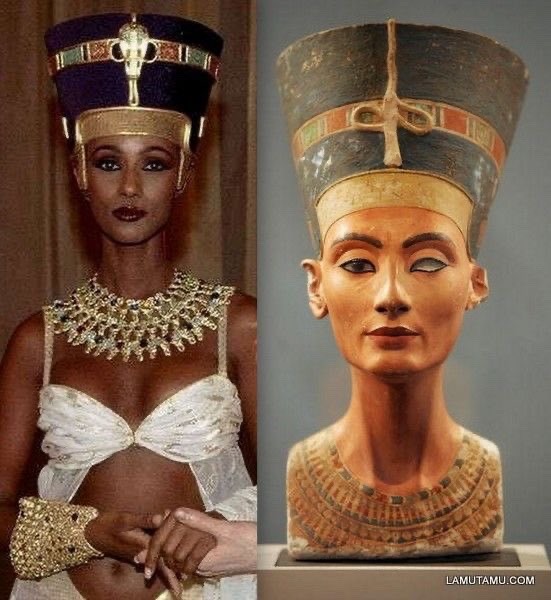Bone sets the tone
I always say, bone sets the tone. It’s a motto that has shaped my career, my practice, and my procedures. The bone sets the tone. It always has. The foundation of what we call attractive is comprised of bone structure. “I was lucky to have been born with cheekbones,” said Suzy Parker, Coco Chanel’s most iconic model.The Beauty Queen: Boning up on the Ancients
It’s a standard that’s as true now as it was for thousands of years before Ms. Parker.My favorite example is the long-reigning beauty queen, Nefertiti.


Nefertiti’s bone structure has withstood the test of time. Look at her striking features emerging all the way from the 18th Dynasty of Ancient Egypt, immortalized in limestone and stucco.
Remember the time?
For a flesh-and-blood representation of this bone structure, consider the model Iman’s (Iman Abdulmajid) impersonation of an Egyptian Queen in Michael Jackson’s “Remember the Time” music video.
Good bone structure is strong bone structure
What exactly comprises bone structure? Or, more specifically, what is broadly considered “good” bone structure? It’s not as subjective as you might think, and good bone structure crosses gender lines,
It’s the cheekbones. The jawline. The chin. Proportion matters, of course. But good bone structure is always strong bone structure,.and that goes for women as well as men.
Bone battle royale: Kate vs. Will
Look at Kate Middleton’s bone structure next to William’s. Which is more attractive? Note which one is stronger! (Much stronger, sorry Wills).

The superficial features of the face, on the skin’s surface, all rely on how they drape upon the solid underlying skeletal structure..
Genetics dictate the shape that bone takes.. After facial development is completed, you either have these features—or you don’t. This was once a final diagnosis, an unalterable outcome aside from the highly skilled application of make up to highlight and shade certain parts of the face.
So what’s left for those who are dissatisfied with their bone structure, whether from their genetics, or after weight loss—or, simply, due to the natural aging process?
Bone structure solutions
One solution is plastic surgery, Facial implants have emerged as a solution to address the absence of the strong bone structure necessary for achieving an aesthetically pleasing balance between your facial features.
Cheek implants have proven effective in restoring volume to the mid-face, addressing the hollow and gaunt look that may develop over time. A weak chin or a poorly defined jawline often contributes to a sense of heaviness in the lower face, and a weak jawline can accentuate neck fat due to the lack of distinct separation between the facial and neck regions.
The drawbacks are rather severe, though. Implants may shift or become displaced over time and can feel or look unnatural, especially if the size or placement is not well-suited to your facial anatomy. Then there’s the possibility of nerve damage, as the surgical process of placing cheek implants involves navigating facial nerves. Numbness or altered sensation may occur, and sometimes the edges of implants may become visible or palpable through the skin, particularly if the soft tissue is thin. This can compromise the aesthetic result and may necessitate revision surgery.
Better bone structure solutions
Nonsurgical facelifts involve minimal or no incisions, reducing the risk of scarring and shortening the recovery time compared to traditional surgical facelifts. Since there is no major surgery involved, the recovery time for nonsurgical facelift procedures is minimal. Patients can often resume their daily activities shortly after the treatment.
Nonsurgical facelifts are associated with less discomfort compared to surgical procedures. Topical or local anesthesia is often sufficient for these treatments, minimizing the need for general anesthesia.
Skilled practitioners can achieve natural-looking results with nonsurgical facelift procedures. By strategically targeting specific areas of concern, especially along the most prominent bones of the face, what I call its leading edges.
Done with exacting techniques and specific tools, these treatments can enhance facial features without appearing artificial.
Nonsurgical facelifts offer a range of customizable options to address individual concerns. Whether targeting wrinkles, sagging skin, or loss of volume, practitioners can tailor treatments to meet the unique needs of each patient.
Many nonsurgical facelift procedures stimulate collagen production, promoting skin elasticity and firmness. This natural enhancement helps improve skin texture and tone over time, and nonsurgical facelifts can be applied to various facial areas, including the forehead, cheeks, jawline, and neck. This versatility allows patients to address specific concerns or achieve an overall facial rejuvenation.
Since nonsurgical facelifts often use topical or local anesthesia, the associated risks and side effects of general anesthesia are minimized. Another critical component of nonsurgical facelift treatments is their minimal downtime, allowing individuals to resume their normal activities shortly after the procedure. This is particularly appealing to those with busy lifestyles.
Some nonsurgical treatments offer temporary results, providing patients with the flexibility to try different options without a long-term commitment. If desired, treatments can be adjusted or repeated—and reversed entirely.

Beauty doesn’t have to be a Beast
To further prove my point, look at Belle (at left). Even our animations follow the timeless foundations of beauty.
What was once a terminal diagnosis: not a fatal one, of course, but it had no solutions. we now have impressive minimally invasive, non-incisional face and neck lift procedures that effectively contour the face and neck, creating the appearance of strong bone structure and addressing neck sagging, hanging jowls, and correcting unsightly nasolabial folds.
Remember, the bone sets the tone!
Yes, I mentioned the King of Pop in an article on bone structure. Sorry, Mr. Jackson.


